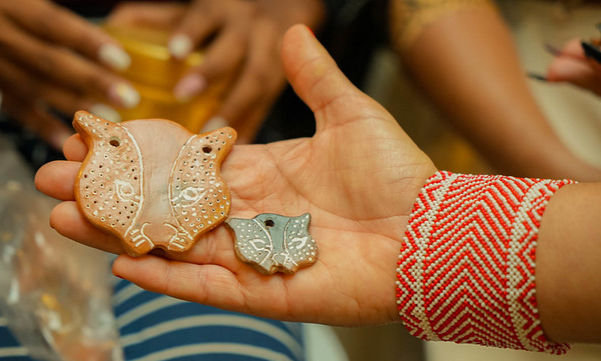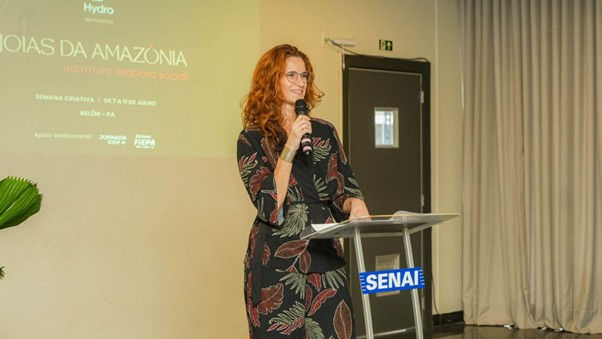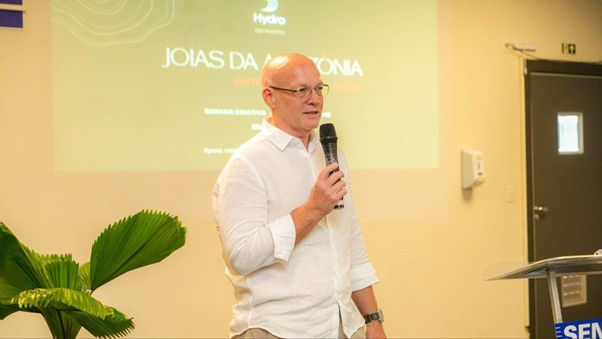Project Brings Together the Knowledge of Amazonian Artisansa
- Maria Luiza Martins
- Sep 22
- 4 min read

Born and raised in the Quilombo da Boa Vista, in the Alto Trombetas region, municipality of Oriximiná, in western Pará, Josane Andrade is one of the faces of Amazonian handicrafts. Her connection with art began in childhood, by observing her mother and grandmother producing ceramics inspired by Konduri culture, an archaeological legacy originating from the region. In the hands of Josane and the women in her family, this ceramic becomes bio-jewelry.

Seeds and African fabrics are also used by the artisan to make earrings, necklaces, bracelets, and other pieces. An art that symbolizes the resistance of quilombola peoples in the Amazon. Josane’s quilombo was the first to be granted land title in Brazil. “It is an honor to represent my people. My bio-jewelry is more than an ornament. It represents my strength, my history, my grandmother, my mother, and all the women who came before me. It carries the knowledge of those who resisted so that I could be here,” says Josane.
In July this year, the artisan left the municipality of Oriximiná for the first time. She visited Santarém, and then Belém. The reason: she was one of sixteen artisans selected to participate in the Jewels of the Amazon Project, an initiative that seeks to highlight the handicrafts produced by women in the region.
Women’s Autonomy
Carried out by the Instituto Elabora Social, sponsored by Hydro and supported by the Federation of Industries of the State of Pará (FIEPA) and the COP+ Journey, the project brings together women from various parts of Pará to create a collection of bio-jewelry that values Amazonian identity and will be showcased during COP30 in Belém.
According to Nathalie Kuperman, founder and CEO of Instituto Elabora Social, the project aims to strengthen sustainable and social jewelry. “We want to give visibility to Amazonian jewelry, which is very diverse and created by women from different backgrounds. The goal is to present this jewelry with all its richness, unique beauty, and territorial ancestry,” she says.

For a week, the artisans gathered in an immersive creative process. With the support of specialized mentors, each artisan created pieces for the collection. The program took place at the Fashion Hub of SENAI Getúlio Vargas, in Belém. “It was a pleasure to host this project because we already develop initiatives aimed at generating employability for women. So it connects with our purpose of preparing women to enter the labor market,” explains Clarisse Fonseca, manager of the hub, who also leads the Committee of Women and Traditional Peoples of the COP+ Journey.
The artisans’ work uses raw materials from the region, such as seeds and plant fibers, fish scales, regional ceramics, rubber, tucumã straw, Brazil nut husk, and wood. In this collection, the jewelry will incorporate another material: recycled aluminum provided by Hydro. “It is a great joy to participate in and sponsor this very special project, which unites art, culture, and traditional knowledge. At the end of this process, the artisans will certainly have strengthened their feminine potential, and a whole universe of entrepreneurship and new possibilities will open for them,” highlights Paula Marlieri, Director of External Relations at Norsk Hydro Brazil.
Quilombo
A type of traditional community in Latin America, formed by descendants of enslaved Black people. Their territories may be located in urban or rural areas and usually preserve history, traditions, and their own form of organization. According to the 2022 Demographic Census, carried out by the Brazilian Institute of Geography and Statistics (IBGE), Brazil has more than 1.3 million quilombolas, present in 24 states and the Federal District. In the North of the country, Pará is the state with the largest quilombola population.
Collection of Knowledge and Techniques
The artisans are quilombola, riverside, extractive, and urban women. From Ananindeua, in the Metropolitan Region of Belém, Mônica Moraes creates jewelry in partnership with her sister, Juliana Moraes. The family’s first contact with jewelry came through their brother, who had been invited to create technical drawings for a local artisan but had to withdraw after an allergic reaction to the materials. That was when Juliana decided to continue the work. “She became interested, started helping with the finishing, and I joined soon after. Today I’m 38 years old, and it’s been more than 17 years of work,” says Mônica.
The studio creates original jewelry made from silver, wood, natural gemstones, pearls, and Amazonian seeds. Many pieces are hand-carved, with special attention to textures and the combination of tradition with contemporary design. Mônica emphasizes that the work goes beyond aesthetics. Commissioned pieces require an exercise in listening and connecting with people’s stories. One of the most memorable was a client who wanted to recreate her grandmother’s jewelry based on an old photo. “It wasn’t possible to see all the details, but we did our best to reconstruct that piece with respect and sensitivity. When she received it, she got emotional. It was more than jewelry; it was a symbol of family memory,” she recalls.
In the Jewels of the Amazon Project, the stories of these artisans came together in a moment of collective creation. “Even living on the same land, each artisan has a story, a technique, a different way of looking at art. I really enjoy listening and learning from these differences,” says Mônica.
For Josane, it was a transformative connection. “We see how much each piece carries stories, roots, and struggles. Our bio-jewelry is not just adornment. It carries our soul, the knowledge of our ancestors, our connection with nature and the sacred,” emphasizes the artisan.
The result of this work will be presented during COP30, at the House of Creative Industry, in downtown Belém. The pieces will be sold, and all proceeds will go to the artisans.

“These are entrepreneurial women who, with traditional knowledge and our rich biodiversity, add value to their creations, also incorporating minerals, a vocation of our state. A connection that will improve these women’s lives and lead to the recognition, perhaps worldwide, of this knowledge.”
- Alex Carvalho, president of the FIEPA System and the COP+ Journey







